Blueprints of future climate trends
Extreme GHG and temperature rise rates question linear climate projections
Andrew Glikson
Earth and climate scientist
Australian National University
geospec@iinet.net.au
Abstract
The extreme greenhouse gas (GHG) and temperature rise rates since the mid-1970th raise questions over
linear climate projections for the 21st century and beyond. Under a rise of CO₂-equivalent reaching +500 ppm and
3.0 W/m⁻² relative to 1750, the current rise rates of CO₂ by
2.86 ppm per and recent global temperature rise rate (
0.15-0.20°C per decade) since 1975 are leading to an abrupt
shift in state of the terrestrial climate and the biosphere. By mid-21st century at >750 ppm CO₂-e climate tipping points indicated by
Lenton et al. 2008 and
Schellnhuber 2009 are likely to be crossed. Melting of the Greenland and Antarctic ice sheets has increased by a
factor of more than 5 since 1979–1990. As the ice sheets and sea ice melt, the
albedo flip between reflective ice surfaces and dark infrared-absorbing water results in significant increase of radiative forcing, and complete removal of Arctic sea ice would result in a forcing of about 0.7 W/m⁻² (
Hudson, 2011). The confluence of climate events, including a breach of the circum-Arctic jet stream boundary and a polar-ward migration of
climate zones at a rate of
56-111 km per decade, induce world-wide extreme weather events including
bushfires,
methane release from Arctic permafrost and sediments. For a
climate sensitivity of 3±1.5°C per doubling of atmospheric CO₂, global warming has potentially reached between +2°C to +3
°C above mean pre-industrial temperatures at a rate exceeding the fastest growth rate over the last
55 million years. As ice melt water flow into the oceans temperature polarities between warming continents and cooling tracts of ocean would further intensify extreme weather events under non-linear climate trajectories. The enrichment of the atmosphere in GHG, constituting a shift in state of the terrestrial climate, is predicted to delay the onset of the next glacial state by some
50,000 years.
GHG and temperature rise
The paleoclimate record suggests that no event since 55 million years ago, the Paleocene-Eocene Thermal Maximum (
PETM), when global temperatures rose by
more than +5 to +8°C over a period of ~
20,000 years, with a subsequent warming period of up to 200,000 years, has been as extreme as atmospheric disruption since the onset of the industrial age about 1750 AD (the Anthropocene), accelerating since 1975. During this period greenhouse gas levels have risen from ~280 ppm to above >
410 ppm and to
496 ppm CO₂-equivalent (Figure 1), the increase of CO₂ reaching near-47 percent above the original atmospheric concentration. However, linear climate change
projections are rare in the recent climate history (Figure 2) and linear future climate projections may not account for the effects of
amplifying feedbacks from land and oceans. Given an Anthropocene warming rate faster by ~X200 times than the PETM (Figure 3), linear warming trajectories such as are projected by the
IPCC may overlook punctuated tipping points, transient reversals and
stadial events.
 |
Figure 1. Growth of CO₂-equivalent level and the annual greenhouse gas Index (NOAA AGGI).
Measurements of CO₂ to the 1950s are from (Keeling et al., 2008) and from air trapped in ice and
snow between CO₂ concentrations and radiative forcing from all long-lived greenhouse gases. |
According to
NOAA, GHG forcing in 2018 has reached 3.101 W/m⁻² relative to 1750 (CO₂ = 2.044 W/m⁻²; CH₄ = 0.512 W/m⁻²; N₂O = 0.199 W/m⁻²; CFCs = 0.219 W/m⁻²) with a CO₂-equivalent of 492 ppm (Figure 1). The rise in GHG forcing during the Anthropocene since about 1800 AD, intensifying since 1900 AD and sharply accelerating since about 1975, has induced a mean of ~1.5°C over the continents above pre-industrial temperature, or >2.0°C when the
masking role of aerosols is discounted, implying further warming is still in store.
According to
Hansen et al. 2008, the rise in radiative forcing during the Last Glacial Termination (LGT -
18,000 -11,000 years BP), associated with enhancing feedbacks, has driven GHG radiative forcing by approximately ~3.0 W/m⁻² and a mean global temperature rise of ~4.5°C (Figure 2), i.e. of similar order as the Anthropocene rise since about 1900. However the latter has been reached within a time frame at least X30 times shorter than the LGT, underpinning the extreme nature of current global warming.
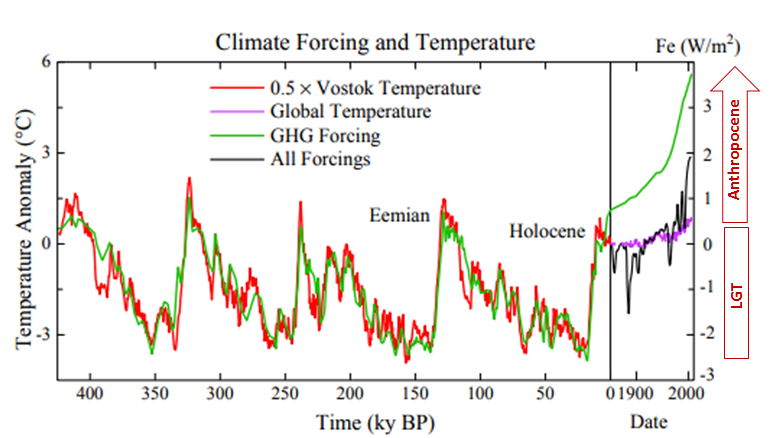 |
Figure 2. (Hansen et al. 2008). Glacial-temperature and GHG forcing for the last 420,000 years based on the Vostok
ice core, with the time scale expanded for the Anthropocoene. The ratio of temperature and forcing scales is 1.5°C
per 1 W/m⁻². The temperature scale gives the expected equilibrium response to GHG change including slow feedback
surface albedo change. Modern forcings include human-made aerosols, volcanic aerosols and solar irradiance. |
The CO₂-equivalent levels and radiative forcing levels constitute a rise from Holocene levels (~280 ppm CO₂) to >410 ppm compared with Miocene-like levels (
300-600 ppm CO₂), at a rate reaching
2 to 3 ppm/year, within a century or so, driving the fastest temperature rise rate recorded since 55 million years ago (Figure 3).
 |
Figure 3. A comparison between rates of mean global temperature rise during: (1) the last Glacial Termination
(3) the late Anthropocene (1750–2016), and (4) an asteroid impact. In the latter instance temperature
due to CO₂ rise would lag by some weeks or months behind aerosol-induced cooling
|
Considering the transient mitigating albedo effects of clouds, seasonal land surface albedo, ice albedo, atmospheric
aerosols including
sulphur dioxide and nitrate,
the potential rise of land temperature could have reached -0.4 to -0.9 W/m⁻² in
2018, masking approximately 0.6 to 1.3°C potential warming once the short lived aerosol effect is
abruptly reduced.
Accelerated melting of the ice sheets
The fast rate of the Anthropocoene temperature rise compared to the LGT and PETM (Figure 3) ensues in differences in terms of the adaptation of flora and fauna to new conditions. The shift in state of the Earth’s climate is most acutely manifested in the poles, where warming leads to weakening of the jet stream boundaries which are breached by outflow of cold air fronts, such as the recent “
Beast from the East” event, and penetration of
warm air masses.
As the poles keep warming, to date by a mean of
~2.3°C, the shrinking of the ice sheets per year has accelerated by a factor of more than
six fold (Figure 4). Warming of the Arctic is driven by the ice-water albedo flip, where dark sea-water absorbing solar energy alternates with high-albedo ice and snow, and by the weakening of the polar boundary and jet stream.
Greenland. The threshold of collapse of the Greenland ice sheet, retarded by
hysteresis, is estimated in the range of
400-560 ppm CO₂, already transgressed at the current 496 ppm CO₂equivalent (Figure 4). The
Greenland mass loss increased from 41 ± 17 Gt/yr in 1990–2000, to 187 ± 17 Gt/yr in 2000–2010, to 286 ± 20 Gt/yr in 2010–2018, or six fold since the 1980s, or 80 ± 6 Gt/yr per decade, on average.
Antarctica. The greenhouse gas level and temperature conditions under which the East Antarctic ice sheet formed during the late Eocene 45-34 million years ago are estimated as ~
800–2000 ppm and up to 4 degrees Celsius above pre-industrial values, whereas the threshold of collapse is estimated as
600 ppm CO₂ or even
lower. The
total mass loss from the Antarctic ice sheet increased from 40 ± 9 Gt/yr in 1979–1990 to 50 ± 14 Gt/yr in 1989–2000, 166 ± 18 Gt/yr in 1999–2009, and 252 ± 26 Gt/yr in 2009–2017. Based on satellite gravity data, the East Antarctic ice sheet is beginning to breakdown in places (
Jones 2019), notably the Totten Glacier (
Rignot et al., 2019), which may be
irreversible. According to
Mengel and Levermann (2014), the Wilkes Basin in East Antarctica alone contains enough ice to raise global sea levels by 3–4 meters.
 |
| Figure 4. (A) New elevation showing the Greenland and Antarctic current state of the ice sheets accurate to a few meters in height, with elevation changes indicating melting at record pace, losing some 500 km³ of ice per-year into the oceans; (B) Ice anomaly relative to the 2002-2016 mean for the Greenland ice sheet (magenta) and Antarctic ice sheet (cyan). Data are from GRACE; (C) the melting of sea ice 1978-2017, National Snow and Ice Data Center (NCIDC) |
C. Migration of climate zones
The expansion of
warm tropical zones and the polar-ward
migration of subtropical and temperate climate zones are leading to a change in state in the global climate pattern. The migration of arid subtropical zones, such as the Sahara, Kalahari and central Australian deserts into temperate climate zones ensues in large scale
droughts, such in inland
Australia and
southern Africa. In the northern hemisphere expansion of the Sahara desert northward, manifested by heat waves across the
Mediterranean and Europe (Figure 5).
 |
Figure 5. (A) Migration of the subtropical Sahara climate zone (red spots) northward into the Mediterranean climate
zone leads to warming, drying and fires over extensive parts of Spain, Portugal, southern France, Italy, Greece and
Turkey, and to melting of glaciers in the Alps. Migration, Environment and Climate Change, International
Organization for Migration Geneva – Switzerland (GMT +1); Source: https://environmentalmigration.iom.int/maps |
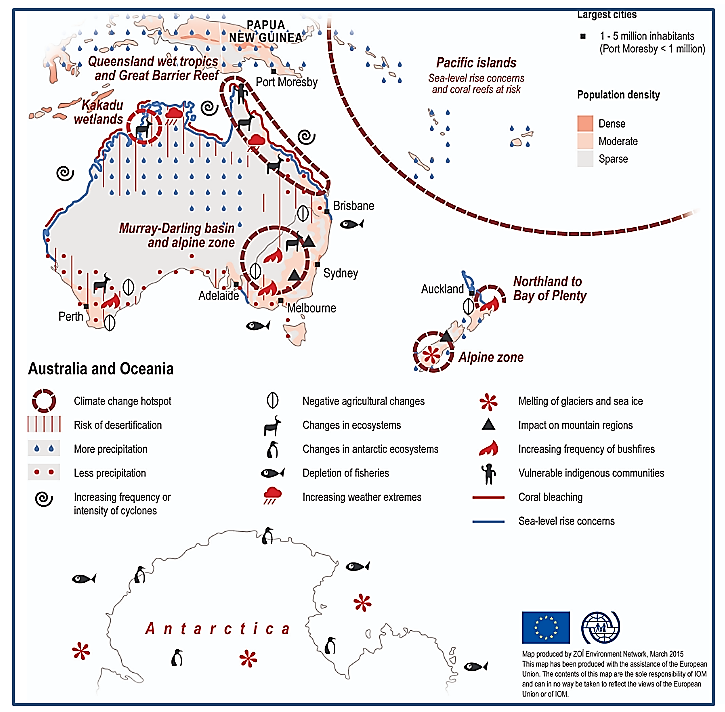 |
Figure 5. (C) Drying parts of southern Australia, including Western Australia, South Australia and parts of the
eastern States, accompanied with increasing bushfires. Source: https://environmentalmigration.iom.int/maps |
Climate extremes
Since the bulk of terrestrial vegetation has evolved under glacial-interglacial climate conditions, where GHG range between 180 - 300 ppm CO₂, global warming is turning large parts of Earth into a tinderbox, ignited by natural and human agents. By July and August 2019, as fires rage across large territories, including the Amazon forest, dubbed the
Planet’s lungs as it enriches the atmosphere in oxygen. When burnt the rainforest becomes of source of a large amount of CO₂ (Figure 6.B), with some
72,843 fires in Brazil this year and extensive bushfires through
Siberia, Alaska, Greenland, southern Europe, parts of Australia and elsewhere, the planet’s biosphere is progressively transformed. As
reported: ‘Climate change is making dry seasons longer and forests more flammable. Increased temperatures are also resulting in more frequent tropical forest fires in non-drought years. And climate change may also be driving the increasing frequency and intensity of climate anomalies, such as El Niño events that affect fire season intensity across Amazonia.’
Extensive cyclones, floods, droughts, heat waves and fires (Figure 6.B) increasingly ravage large tracts of Earth. However, despite its foundation in the basic laws of physics (the
black body radiation laws of Planck, Kirchhoff' and Stefan Boltzmann), as well as empirical observations around the world by major climate research bodies (NOAA, NASA, NSIDC, IPCC, World Meteorological Organization, Hadley-Met, Tindale, Potsdam, BOM, CSIRO and others), the anthropogenic origin, scale and pace of climate change remain subject to extensively propagated
denial and untruths.
 |
Figure 6. (A) Extreme weather events around the world 1980-2018,
including earthquakes, storms, floods, droughts. Munich Re-insurance. |
 |
| Figure 6. (B) A satellite infrared image of South America fires (red dots) during July and August, 2019, NASA. |
An uncharted climate territory
Whereas strict analogies between Quaternary and Anthropocene climate developments are not possible, elements of the glacial-interglacial history are relevant for an understanding of current and future climate events. The rise of total greenhouse gas (GHG), expressed as CO₂-equivalents, to 496 ppm CO₂-e (Figure 1), within less than a century represents an extreme atmospheric event. It raised GHG concentrations from Holocene levels to the range of the Miocene (34–23 Ma) when CO₂ level was between
300 and 530 ppm. As the glacial sheets disintegrate, cold ice-melt water flowing into the ocean ensue in large cold water
pools, a pattern recorded following peak interglacial phases over the
last 450,000 years, currently manifested by the growth of cold regions in north Atlantic Ocean
south of Greenland and in the Southern Ocean fringing Antarctica (Figure 7).
Warming of +3°C to +4°C above pre-industrial levels, leading to enhanced ice-sheet melt, would raise sea levels by at least
2 to 5 meters toward the end of the century and, delayed by
hysteresis, likely by 25 meters in the longer term.
Golledge et al. (2019) show meltwater from Greenland will lead to substantial slowing of the Atlantic overturning circulation, while meltwater from Antarctica will trap warm water
below the sea surface, increasing Antarctic ice loss. Whereas the effect of low-density ice melt water on the surrounding oceans is generally not included in many models, depending on
amplifying feedbacks, prolonged Greenland and Antarctic melting and consequent cooling of surrounding ocean sectors as well as penetration of freezing air masses through
weakened polar boundaries may have profound effect on future climate change trajectories (Figure 8).
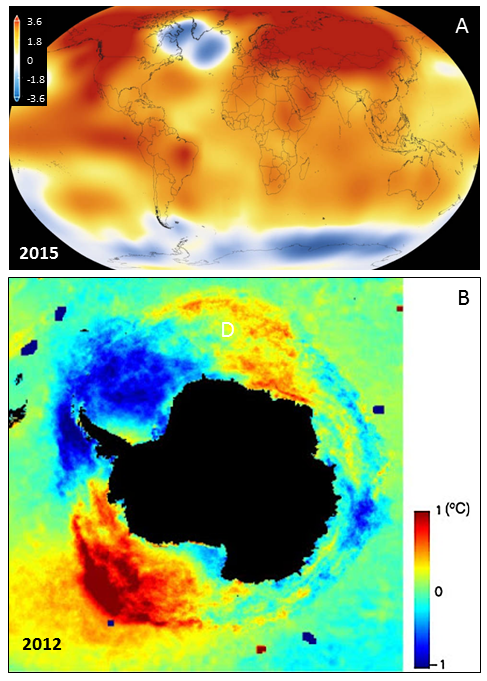 |
Figure 7. (A) Global warming map (NASA 2018). Note the cool ocean regions south of Greenland and
along the Antarctic. Credits: Scientific Visualization Studio/Goddard Space Flight Center;
(B) 2012 Ocean temperatures around Antarctica (NASA 2012). |
Climate projections for 2100-2300 by the IPCC
AR5 Synthesis Report, 2014 portray predominantly
linear to curved models of greenhouse gas, global temperatures and sea level changes. These models however appear to take limited account of
amplifying feedbacks from land and ocean and of the effects of cold ice-melt on the oceans. According to
Steffen et al. (2018) “self-reinforcing feedbacks could push the Earth System toward a planetary threshold” and “would lead to a much higher global average temperature than any interglacial in the past 1.2 million years and to sea levels significantly higher than at any time in the Holocene”.
Amplifying feedbacks of global warming include:
- The albedo-flip of melting sea ice and ice sheets and the increase of the water surface area and thereby sequestration of CO₂. Hudson (2011) estimates a rise in radiative forcing due to removal of Arctic summer sea ice as 0.7 W/m², a value close to the total of methane release since 1750.
- Reduced ocean CO₂ intake due to lesser solubility of the gas with higher temperatures.
- Vegetation desiccation and burning in some regions, and thereby released CO₂ and reduced evaporation and its cooling effect. This factor and the increase of precipitation in other regions lead to differential feedbacks from vegetation as the globe warms (Notaro et al. 2007).
- An increase in wildfires, releasing greenhouse gases (Figure 6).
- Release of methane from permafrost, bogs and sediments and other factors.
Linear temperature models appear to take limited account of the effects on the
oceans of ice melt water derived from the large ice sheets, including the possibility of a significant
stadial event such as already started in oceanic tracts fringing Greenland and Antarctica (Figure 7) and modeled by
Hansen et al, (2016). In the shorter to medium term sea level rises would ensue from the Greenland ice sheet (
6-7 meter sea level rise) and West Antarctic ice sheet melt (
4.8 meter sea level rise). Referring to major past stadial events, including the 8200 years-old
Laurentian melt and the
12.7-11.9 younger dryas event, a protracted breakdown of parts of the Antarctic ice sheet could result in major sea level rise and extensive cooling of southern latitudes and beyond, parallel with warming of tropical and mid-latitudes (Figure 8) (
Hansen et al. 2016). The temperature contrast between polar-derived cold fronts and tropical air masses is bound to lead to extreme weather events, echoed among other in Storms of my grandchildren (
Hansen, 2010).
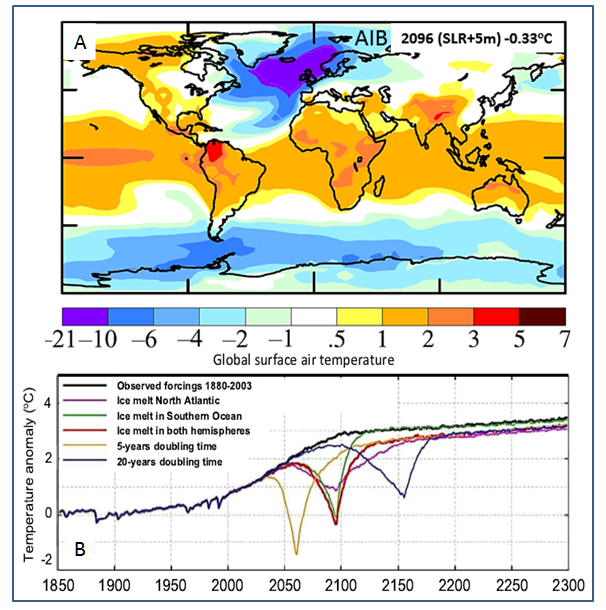 |
Figure 8. (A) Model Surface-air temperature (°C) for 2096 relative to 1880–1920 (Hansen et al. 2016).
The projection betrays major cooling of the North Atlantic Ocean, cooling of the circum-Antarctic Ocean
and further warming in the tropics, subtropics and the interior of continents; (B) Modeled surface-air
temperatures (°C) to 2300 AD relative to 1880–1920 for several ice melt rate scenarios, displaying a stadial cooling event at a time dependent on the ice melt doubling time (Hansen et al., 2016). Courtesy Prof James Hansen;. |
Within and beyond 2100-2300 projections (Figure 8.A, B) lies an uncharted climate territory, where continuing melting of the Antarctic ice sheet, further cooling of neighboring sectors of the oceans and climate contrasts with GHG-induced warming of land areas (Figure 8.A), ensue in chaotic climate disruptions (Figure 8.B). Given the thousands to tens of thousands years longevity of atmospheric greenhouse gases (
Solomon et al., 2009;
Eby et al 2009), the onset of the next ice age is likely to be delayed on the scale of tens of thousands of years (
Berger and Loutre, 2002) through an exceptionally long interglacial period (Figure 9).
These
authors state: ‘The present day CO₂ concentration (now >410 ppm) is already well above typical interglacial values of ~290 ppmv. This study models increases to up to 750 ppmv over the next 200 years, returning to natural levels by 1000 years. The results suggest that, under very small insolation variations, there is a threshold value of CO₂ above which the Greenland Ice Sheet disappears. The climate system may take 50,000 years to assimilate the impacts of human activities during the early third millennium. In this case, an “irreversible greenhouse effect” could become the most likely future climate. If the Greenland and west Antarctic Ice Sheets disappear completely, then today’s “Anthropocene” may only be a transition between the Quaternary and the next geological period.’
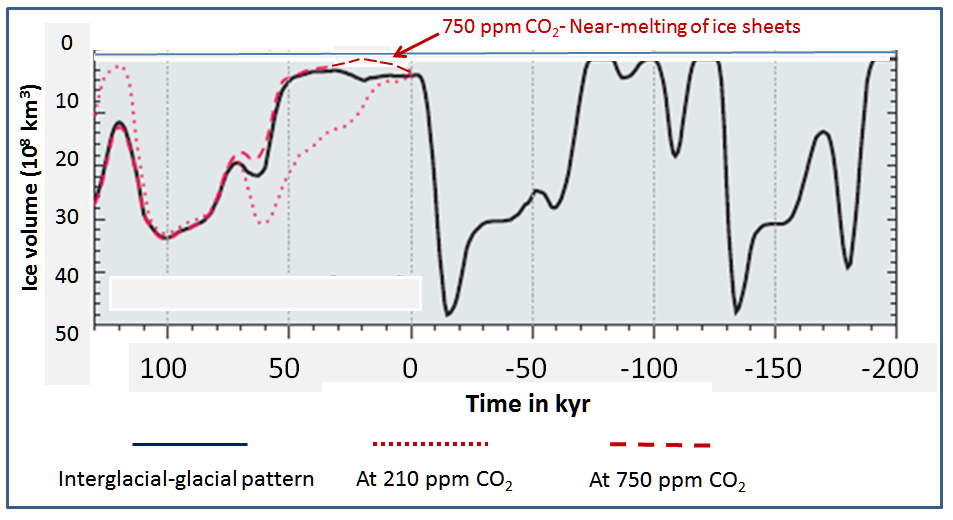 |
| Figure 9. Simulated Northern Hemisphere ice volume (increasing downward) for the period 200,000 years BP to 130,000 years in the future, modified after a part of Berger and Loutre 2002. Time is negative in the past and positive in the future. For the future, three CO2 scenarios were used: last glacial-interglacial values (solid line), a human-induced concentration of 750 ppm (dashed line), and a constant concentration of 210 ppm inducing a return to a glacial state (dotted line). |
As conveyed by leading scientists “Climate change is now reaching the end-game, where very soon humanity must choose between taking unprecedented action or accepting that it has been left too late and bear the consequences” (
Prof. Hans Joachim Schellnhuber) …“We’ve reached a point where we have a crisis, an emergency, but people don’t know that ... There’s a big gap between what’s understood about global warming by the scientific community and what is known by the public and policymakers” (
James Hansen).
Climate scientists find themselves in a quandary similar to medical doctors, committed to help the ill, yet need to communicate grave diagnoses. How do scientists tell people that the current spate of
extreme weather events, including cyclones, devastating islands from the Caribbean to the Philippine,
floods devastating coastal regions and river valleys from Mozambique to Kerala, Pakistan and Townsville, and fires burning extensive tracts of the living world, can only intensify in a rapidly warming world? How do scientists tell the people that their children are growing into a world where survival under a mean temperature higher than +2 degrees Celsius (above pre-industrial temperature) is likely to be painful and, in some parts of the world, impossible, let alone under +4 degrees Celsius
projected by the IPCC?
Summary and conclusions
- The current growth rate of atmospheric greenhouse gas is the fastest recorded for the last 55 million years.
- By the mid-21st century, at the current CO₂ rise rates of 2 to 3 ppm/year, a CO₂-e level of >750 ppm is likely to transcend the climate tipping points indicated by Lenton et al. 2008 and Schellnhuber 2009.
- The current extreme rise rates of GHG (2.86 ppm CO₂/year) and temperature (0.15-0.20°C per decade since 1975) raise doubt with regard to linear future climate projections.
- Global greenhouse gases have reached a level exceeding the stability threshold of the Greenland and Antarctic ice sheets, which are melting at an accelerated rate.
- Allowing for the transient albedo-enhancing effects of sulphur dioxide and other aerosols, mean global temperature has reached approximately 2.0 degrees Celsius above per-industrial temperatures.
- Due to hysteresis the large ice sheets would outlast their melting temperatures.
- Land areas would be markedly reduced due to a rise to Miocene-like sea levels of approximately 40±15 meters above pre-industrial levels.
- Cold ice melt water flowing from the ice sheets into the oceans at an accelerated rate is reducing temperatures in large tracts in the North Atlantic and circum-Antarctic.
- Strong temperature contrasts between cold polar-derived and warm tropical air and water masses are likely to result in extreme weather events, retarding habitats and agriculture over coastal regions and other parts of the world.
- In the wake of partial melting of the large ice sheets, the Earth climate zones would continue to shift polar-ward, expanding tropical to super-tropical regions such as existed in the Miocene (5.3-23 million years ago) and reducing temperate climate zones and polar ice sheets.
- Current greenhouse gas forcing and global mean temperature are approaching Miocene Optimum-like composition, bar the hysteresis effects of reduced ice sheets (Figure 4.A).
- The effect of high atmospheric greenhouse gas levels would be for the next ice age to be delayed on a scale of tens of thousands of years, during which chaotic tropical to hyperthermal conditions would persist until solar radiation and atmospheric CO₂ subsided below ~300 ppm.
- Humans will survive in relatively favorable parts of Earth, such as sub-polar regions and sheltered mountain valleys, where gathering of flora and hunting of remaining fauna may be possible.
A Postscript
The author, while suggesting the projections made in this paper are consistent with the best climate science with which he is aware, sincerely hopes the implications of these projections would not eventuate.
 The United Nations Environment Programme (UNEP) just released its annual Emissions Gap Report, warning that even if all current unconditional commitments under the Paris Agreement are implemented, temperatures are expected to rise by 3.2°C, bringing even wider-ranging and more destructive climate impacts.
The United Nations Environment Programme (UNEP) just released its annual Emissions Gap Report, warning that even if all current unconditional commitments under the Paris Agreement are implemented, temperatures are expected to rise by 3.2°C, bringing even wider-ranging and more destructive climate impacts.





























